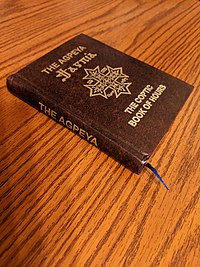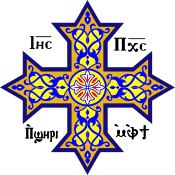
| Part of a series on the |
| Copts |
|---|
| Culture |
| Regions |
| Denominations |
|
|
The Agpeya (Coptic: Ϯⲁⲅⲡⲓⲁ, Arabic: أجبية) is the Coptic Christian "Prayer Book of the Hours" or breviary, and is equivalent to the Shehimo in the Syriac Orthodox Church (another Oriental Orthodox Christian denomination), as well as the Byzantine Horologion and Roman Liturgy of the Hours used by the Eastern Orthodox Church and Roman Catholic Church, respectively. The Agpeya prayers are popular Christian prayers recited at fixed prayer times, facing the east by both individuals and families at home seven times a day, as well as for communal prayers as an introduction to Mass at church; this Christian practice has its roots in Psalm 119:164, in which the prophet David prays to God seven times a day.[1][2] The vast majority of the Coptic Christians learn the recitation and prayers of the Agpeya at an early age as children at home from their families. The Coptic Orthodox cycle of canonical hours is primarily composed of psalm readings from the Old Testament and gospel readings from the New Testament, with some added hymns of praise, troparia (known as "قطع" in the contemporary Arabic Agpeya and as "preces" or "litanies" in English), and other prayers.
Prostrations to God are a cornerstone in praying the Agpeya, with the breviary requiring "prostrating three times in the name of the Trinity; at the end of each Psalm … while saying the ‘Alleluia’; and multiple times" during the forty-one Kyrie eleisons (believers may use the mequteria to count these metanoias).[3]
It includes seven canonical hours, with an additional "Prayer of the Veil" which is usually recited by Bishops, Priests, and Monks. The Coptic terms for 'Matins' and 'Vespers' are 'The Morning Raising of Incense' and 'The Evening Raising of Incense' respectively, with reference to prayers rising to God.
Before praying the Agpeya, Coptic Christians wash their hands and face in order to be clean before and present their best to God; shoes are removed in order to acknowledge that one is offering prayer before a holy God.[4][3] In this Christian tradition, and in many others as well, it is customary for women to wear a Christian headcovering when praying, a practice explicated in 1 Corinthians 11:5–6.[5][6] While praying the Agpeya, many believers hold a cross in their hand during the parts where the believer is standing (during which he/she extends his/her arms in the orans position).[7]
- ^ "Prayers of the Church". Ethiopian Orthodox Tewahedo Church. Retrieved 25 July 2020.
- ^ Kalleeny, Tony. "Why We Face the EAST". Orlando: St Mary and Archangel Michael Church. Retrieved 6 August 2020.
- ^ a b Kosloski, Philip (16 October 2017). "Did you know Muslims pray in a similar way to some Christians?". Aleteia. Retrieved 25 July 2020.
- ^ Mary Cecil, 2nd Baroness Amherst of Hackney (1906). A Sketch of Egyptian History from the Earliest Times to the Present Day. Methuen. p. 399.
Prayers 7 times a day are enjoined, and the most strict among the Copts recite one of more of the Psalms of David each time they pray. They always wash their hands and faces before devotions, and turn to the East.
{{cite book}}: CS1 maint: numeric names: authors list (link) - ^ Bercot, David. "Head Covering Through the Centuries". Scroll Publishing. Retrieved 28 April 2016.
- ^ Duffner, Jordan Denari (13 February 2014). "Wait, I thought that was a Muslim thing?!". Commonweal. Retrieved 26 July 2020.
- ^ Dawood, Bishoy. "Stand, Bow, Prostrate: The Prayerful Body of Coptic Christianity: Clarion Review". The Clarion Review.
© MMXXIII Rich X Search. We shall prevail. All rights reserved. Rich X Search

